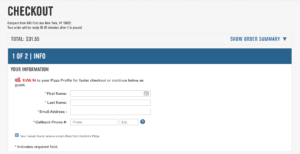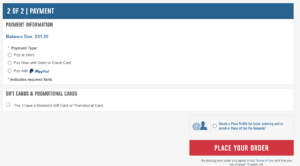Table of Contents
Are you a website owner looking to improve the effectiveness of your online presence? Are you having success with attracting site visitors, but still can’t seem to increase your ROI? If so, then you may need conversion rate optimization services.
But what exactly is CRO, and why should you care about it?
Related Content:
In simple terms, CRO is the process of optimizing your website or landing page to improve the percentage of visitors who take a desired action, such as making a purchase or filling out a form. You could have all the traffic in the world coming to your website, but if none of those visitors are converting into customers, then what’s the point? By focusing on CRO, you can ensure that your website is not only attracting visitors, but also guiding them towards taking the actions you want them to take.
In this blog, we’ll dive deeper into the world of CRO, exploring best practices to help you optimize your website for maximum conversions. So buckle up, and get ready to increase your bottom-line!
What is CRO?
Conversion rate optimization (CRO) is the process of increasing the percentage of website visitors who take a desired action, such as making a purchase, filling out a form, or signing up for a newsletter. It involves analyzing and understanding customer behavior, testing different elements of the website, and making changes to improve the user experience and increase the likelihood of conversion.
CRO is an ongoing process that involves continuous monitoring and analyzing website performance and making adjustments as needed to improve conversion rates. The ultimate goal of CRO is to turn more website visitors into customers or leads by making the website as effective and user-friendly as possible.
Why Should You Care About CRO?
There are several reasons why businesses should care about CRO. These include, but are not limited to:
- Increased revenue: By optimizing the website for conversions, businesses can increase the percentage of visitors who take a desired action, resulting in more sales and revenue.
- Better ROI: CRO allows your business to get more value out of your existing traffic by converting more visitors into customers. This can result in a better return on investment for marketing and advertising efforts.
- Improved user experience: CRO involves analyzing and understanding customer behavior and making changes to improve the user experience. This can lead to a more enjoyable experience for website visitors and increased customer satisfaction.
- Better customer insights: With CRO, you can gain a deeper understanding of your customers and their behavior on the website. This can provide valuable insights that can be used to improve marketing strategies and product offerings.
- Cost-effective: CRO allows businesses to improve website performance and conversions without the need for significant increases in traffic. This can be more cost-effective than other forms of marketing and advertising.
- Competitive advantage: By optimizing their website for conversions, businesses can gain a competitive advantage over others in their industry. A website that is easy to use and effective at converting visitors into customers can give businesses an edge over their competition.
Overall, CRO is a valuable tool for businesses of all sizes and industries, as it can help increase revenue, improve user experience, and provide valuable customer insights. By focusing on CRO best practices, your business can improve it’s website’s performance, and ultimately increase your bottom line.
How Are CRO and SEO Related?
Here at Go Fish Digital, we’re all about Search Engine Optimization. But how does CRO relate to SEO? Well, CRO and SEO are related in that they both aim to improve the performance of a website and drive more conversions. However, they focus on different aspects of website optimization.
SEO (Search Engine Optimization) is the process of optimizing a website to rank higher in search engine results and drive more organic traffic. SEO involves optimizing website content, technical elements, and backlinks to make the site more attractive to search engines and improve its visibility in search results.
CRO (Conversion Rate Optimization), on the other hand, focuses on optimizing the website’s design, user experience, and messaging to increase the percentage of visitors who take a desired action. It involves testing different elements of the website, such as headlines, calls-to-action, and layout, and making changes to improve the user experience and increase the likelihood of conversion. CRO focuses on all users, rather than solely organic traffic.
While SEO and CRO are distinct practices, they both play important roles in driving website performance and conversions. A well-optimized site for SEO can bring a lot of visitors, but a poorly designed or not very user-friendly site will not convert them into customers. A good balance and integration of both practices can improve the website’s overall performance, driving more traffic and converting more visitors into customers.
What Are CRO Best Practices?
The best practices for CRO are to:
- Make sure your website has a clear value proposition
- Use a clear and simple design that is easy to navigate
- Use persuasive and compelling language throughout the site
- Use social proof, such as customer testimonials and trust badges
- Make sure the website loads quickly and is optimized for all devices
- Use A/B testing to constantly improve your website’s design and messaging
- Use clear and prominent calls-to-action (CTAs) throughout the site
- Make sure the checkout process is as simple and seamless as possible
- Use retargeting to bring back visitors who have abandoned their carts
- Continuously analyze and track your website’s performance using tools like Google Analytics
Now that we’ve nailed the importance of conversion rate optimization, here are some general CRO best practices that you can use to increase conversions on your website. Depending on the type of site and your conversion goals, there are variations of these best practices that may better fit your needs. For example, improving your CRO for an e-commerce site will look different than optimizing for conversions on a lead-generation site. However, following these steps will put you well on your way to increasing user experience and conversions through your website!
1. Make sure your website has a clear and compelling value proposition and display this on your primary landing page.
The first CRO best practice involves in your landing pages. Your landing page is the first and foremost element on your site, meaning that it could determine the success of your brand. The first 3-5 seconds of a user’s journey on your site is crucial to turning them into a converting customer – if they can immediately determine the brand’s offerings and an actionable next step, your potential conversion rate will increase significantly. Be sure to follow these guidelines:
- Identify the unique value that your product or service offers to customers.
- Use this value proposition on the homepage and within the headlines throughout the site.
- Test different versions of your value proposition to see which one resonates most with your audience.
Upon landing on Khan Academy’s homepage, users can determine exactly what their services include and who their primary audience is:
Learn more about homepage conversion rate optimization best practices!
2. Use a clear and simple design that is easy to navigate.
It’s a CRO best practice to reduce any potential frustration by making it easy for users to find what they’re looking for – don’t make it a maze! A visually appealing and simple web design not only helps users find their desired conversion funnel but makes them feel good while doing so. Stick to these rules:
- Make sure the layout of your site is intuitive and easy to follow.
- Use a consistent color scheme and typography throughout the site.
- Keep the concept of visual hierarchy in mind to ensure your most important elements are communicated to users appropriately.
Rover offers a clean, simple, and intuitive navigation design:
3. Use persuasive and compelling language throughout the site.
We all understand the value of persuasion in increasing conversion, but implementing it is a different story. Tell users exactly what their next step should be – click, register, shop – and why they should do it – for a free demo, to receive more information. Don’t make them think any harder than they need to! Follow these tips:
- Use action-oriented and benefit-driven language throughout the site.
- Use persuasive techniques like scarcity and urgency in your messaging.
- Try out different versions of your messaging to see which ones perform best.
4. Use social proof, such as customer testimonials and trust badges.
Consumers rarely want to be the guinea pig. The first thing we all do when discovering a new product is conduct our due diligence – How many people have tried it? How did they like it? How reputable are these reviewers? And so on. With CRO best practices in mind, be sure to:
- Gather testimonials from satisfied customers and prominently display them on the site.
- Use trust badges from well-known organizations to build credibility.
- Test different types of social proof, and different display practices, to see which ones are most effective.
Notion displays its social proof right below the fold on their homepage:
5. Make sure the website loads quickly and is optimized for all devices.
These days, it’s safe to say that most of us are navigating the world wide web on our handy mobile devices. If the majority of your users are mobile, what good would a fully optimized desktop experience do, with a forgotten and lacking mobile experience? If users land on a glitchy, non-responsive mobile site, they’ll likely bounce and click the next search result without a second thought. Same idea with load speed. Be sure to:
- Use tools like Google’s PageSpeed Insights to identify areas for improvement.
- Optimize images and other large files to reduce loading times.
- Gather user engagement data to identify where you can reduce unnecessary files or dynamic, heavy elements.
Learn more about when to run an A/B test, and the most efficient way to run A/B tests
6. Use A/B testing to constantly improve your website’s design and messaging.
Us marketers love our A/B testing – and for good reason. If you’re able to try new design ideas that result in real-time, statistically significant user behavior data, you absolutely should. Your competitors will! Keep up with them and:
- Use tools like Google Optimize to run A/B tests on different elements of your site.
- Test different versions of headlines, calls-to-action, and other key elements or design elements.
- Continuously analyze the results of your tests and make changes accordingly.
7. Use clear and prominent calls-to-action (CTAs) throughout the site.
Nothing (aka not a lot) beats simplicity. Especially in a world of constant information exposure and an unlimited number of options at every turn. Hook your users with concise, but descriptive language – don’t overwhelm them with too much, too fast. Let them get their feet wet in your brand’s products/services through headings, call-to-action banners, or simple graphics. Always:
- Use action-oriented language in your CTAs.
- Make sure your CTAs stand out visually and are prominently placed.
- Test different versions of your CTAs to see which ones perform best.
Rover includes prominent CTAs on each service page:
8. Make sure the checkout process is as simple and seamless as possible.
Users are never fully committed until they’ve fully committed. With that in mind, your site has to be a smooth ride from start to finish – especially the part where they hand over some of their most important information. Another CRO best practice is to help them through the finish line with these items:
- Keep the number of form fields to a minimum.
- Use progress indicators to let customers know how far along they are in the process.
- Display trust signals specific to your checkout method, such as a Secure Checkout badge for money purchases.
Dominos does this particularly well:
9. Use retargeting to bring back visitors who have abandoned their carts.
As I said, they’re never fully committed until they’ve hit that bright blue ‘Checkout’ button. If they abandon their cart, this means they were almost convinced, but they may need an extra push. If this seems to happen often, you can:
- Use tools like Google AdWords to target ads to people who have abandoned their carts.
- Use retargeting ads to remind customers of what they left behind.
- Test different versions of your retargeting ads to see which ones perform best.
10. Continuously analyze and track your website’s performance using tools like Google Analytics.
As they say, marketing is a long game. Supply, demand, and competitors will never cease – so why should you? Continue your conversion efforts with the following CRO best practices:
- Use Google Analytics to track key metrics like bounce rate, conversion rate, and revenue.
- Use goals and funnels to track progress through the customer journey.
- Perform quarterly goal auditing to ensure your goals and events are being tracked properly.
Final Words: CRO Best Practices
Well, we’ve come to the end of our discussion on conversion rate optimization (for now). I hope you’ve found this blog helpful in understanding the importance of CRO best practices and how they can help increase your bottom-line, improve the user experience of your website, and provide valuable customer insights that can be used by all marketing verticals. Remember, the key to successful CRO is to constantly test, iterate, and improve. Don’t be afraid to try new things and take calculated risks to see what works best for your website and your audience. With the right approach and mindset, you can unlock a wealth of opportunities for growth and success. So go ahead and start optimizing your conversion rates today, and watch your business soar to new heights!
Learn more about Go Fish Digital’s CRO services today.
Search News Straight To Your Inbox
*Required
Join thousands of marketers to get the best search news in under 5 minutes. Get resources, tips and more with The Splash newsletter:





